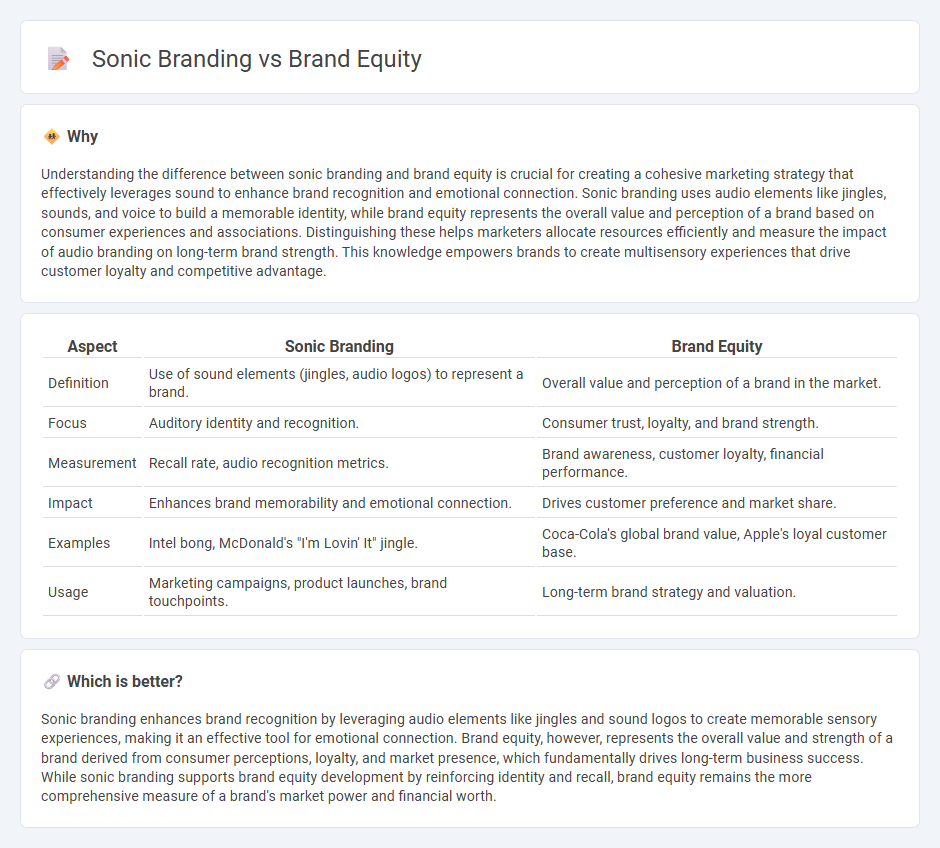
Sonic branding leverages distinctive audio elements to create instant brand recognition and emotional connection, enhancing customer recall and engagement. Brand equity represents the overall value and strength of a brand in the marketplace, driven by consumer perception, loyalty, and awareness. Explore how integrating sonic branding can elevate your brand equity and drive marketing success.
Why it is important
Understanding the difference between sonic branding and brand equity is crucial for creating a cohesive marketing strategy that effectively leverages sound to enhance brand recognition and emotional connection. Sonic branding uses audio elements like jingles, sounds, and voice to build a memorable identity, while brand equity represents the overall value and perception of a brand based on consumer experiences and associations. Distinguishing these helps marketers allocate resources efficiently and measure the impact of audio branding on long-term brand strength. This knowledge empowers brands to create multisensory experiences that drive customer loyalty and competitive advantage.
Comparison Table
| Aspect | Sonic Branding | Brand Equity |
|---|---|---|
| Definition | Use of sound elements (jingles, audio logos) to represent a brand. | Overall value and perception of a brand in the market. |
| Focus | Auditory identity and recognition. | Consumer trust, loyalty, and brand strength. |
| Measurement | Recall rate, audio recognition metrics. | Brand awareness, customer loyalty, financial performance. |
| Impact | Enhances brand memorability and emotional connection. | Drives customer preference and market share. |
| Examples | Intel bong, McDonald's "I'm Lovin' It" jingle. | Coca-Cola's global brand value, Apple's loyal customer base. |
| Usage | Marketing campaigns, product launches, brand touchpoints. | Long-term brand strategy and valuation. |
Which is better?
Sonic branding enhances brand recognition by leveraging audio elements like jingles and sound logos to create memorable sensory experiences, making it an effective tool for emotional connection. Brand equity, however, represents the overall value and strength of a brand derived from consumer perceptions, loyalty, and market presence, which fundamentally drives long-term business success. While sonic branding supports brand equity development by reinforcing identity and recall, brand equity remains the more comprehensive measure of a brand's market power and financial worth.
Connection
Sonic branding enhances brand equity by creating distinctive audio cues that improve brand recognition and recall, reinforcing emotional connections with consumers. Consistent use of unique sound elements strengthens brand identity and differentiates the brand in competitive markets. Effective sonic branding increases perceived brand value, contributing to long-term customer loyalty and higher brand equity.
Key Terms
Brand Recognition
Brand equity encompasses the overall value and perception of a brand, heavily influenced by factors like brand recognition, which measures how easily consumers identify a brand through visual and auditory cues. Sonic branding specifically targets auditory elements, such as jingles, sound logos, and audio signatures, to enhance brand recognition by engaging consumers' senses and creating memorable associations. Explore how integrating sonic branding into your strategy can strengthen your brand recognition and elevate overall brand equity.
Emotional Connection
Brand equity builds long-term emotional connections through consistent brand values, identity, and consumer trust, while sonic branding leverages sound elements to create immediate emotional resonance and enhance brand recall. Both strategies deepen consumer relationships by tapping into emotions, with sonic branding providing a distinctive audio signature that reinforces brand identity across multiple platforms. Discover how integrating these approaches can elevate your brand's emotional impact and market presence.
Audio Logo
Brand equity represents the overall value a brand holds in consumers' minds, shaped by factors like recognition, reputation, and emotional connections. Sonic branding, particularly through an audio logo, enhances this equity by creating a unique, memorable sound that strengthens brand recall and emotional engagement. Discover how integrating audio logos can amplify your brand equity and create deeper consumer connections.
Source and External Links
What Is Brand Equity? How To Build Brand Equity (2025) - Shopify - Brand equity is the market strength or value of a brand based on people's perceptions, which influences customer loyalty and pricing power, and can be built over time through consistent quality and customer focus.
Brand Equity: What It Is, Why It Matters & How to Build It - Frontify - Brand equity represents the value customers assign to a brand based on perceived quality, resulting in financial gains, stronger loyalty, less price sensitivity, and increased brand trust.
Brand equity - Wikipedia - Brand equity is the intrinsic worth and social value of a brand, allowing companies to charge premium prices and benefit from brand recognition as consumers perceive branded products as superior.
 dowidth.com
dowidth.com